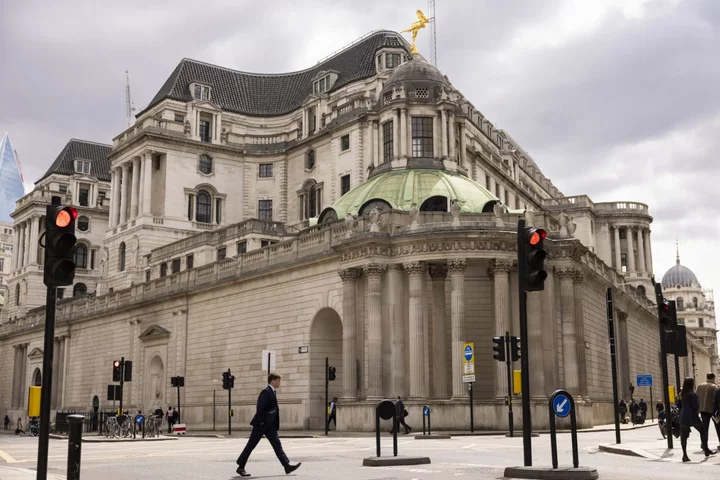UK bond yields are back to where they were when Liz Truss was in No. 10 after a shocking inflation report underscored the need for much tighter monetary policy.
The inflation rate came in higher than all economists forecast — sending wagers on future interest-rate hikes soaring and lifting yields to levels last seen when the former Prime Minister rattled markets with her unvetted mini-budget. The rate on 10-year securities now pays a premium of more than 50 basis points over equivalent US notes, around the biggest seen in more than a decade.
“It’s a terrible inflation print that really sets the UK apart from other major developed economies,” said Derek Halpenny, head of research, global markets EMEA & international securities at MUFG Bank. “The scale of divergence on the inflation path risks undermining policy credibility.”
Soon after the data landed, money markets priced in a peak BOE rate as high as 5.5%, suggesting a full percentage point of hikes through the end of the year. Gilts slid, with two-year yields set for the largest jump since September, when the UK bond market was still in crisis mode.
UK’s Stubbornly High Inflation Fuels Bets for Higher Rates
In October, gilt yields soared to multi-year highs after the former UK government’s fiscal plans put the country’s financial credibility in question and sent panic ripping through markets. The 10-year yield rose to 4.63% on Oct. 12, the highest since 2008, after pension funds were forced to dump their holdings.
Wednesday’s CPI print was seen as a key input for Governor Andrew Bailey on when to ease up an inflation fight that’s taken the key rate from 0.1% a year and a half ago to 4.5% now. The slowdown didn’t match BOE officials’ predictions, while a closely watched gauge that excludes food, energy and tobacco prices, accelerated in April.
Traders are now more than fully pricing a quarter-point hike at the next rate meeting on June 22, implying a possible return to larger, half-point increases. That would mark a reversal since the BOE dialed back the pace of its tightening in March.
The data has “dealt a crushing blow to a beleaguered Bank,” said Jeremy Batstone-Carr, European strategist at Raymond James Investment Services, pointing to core inflation, which accelerated at the fastest pace in more than three decades. “We may still be far from the peak of rate hikes.”
The yield on 10-year gilts was up 8 basis points at 4.24% after rising as much as 21 basis points earlier in the session to the highest since October. The two-year yield jumped as much as 29 basis points to 4.42%.
The pound, which might normally strengthen on the prospect of higher rates, was little changed. After initially jumping as much as 0.5% per dollar, it soon reversed, slipping 0.3% to $1.2373 around 11:15 a.m. in London and suggesting traders didn’t have to unwind bets against the UK currency after the inflation shock.
“I’m surprised sterling isn’t higher on that CPI number,” said Jordan Rochester, a strategist at Nomura who is bearish on the pound against the US dollar. “Perhaps tells you short sterling isn’t a crowded trade at all,” he said.
(Adds context throughout, updates prices.)

